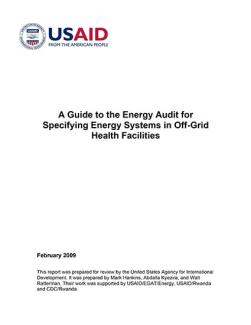Energy Audit Guide: Specifying Energy Systems in Off-Grid Health Facilities
Powering Health Toolkit
Guide –
Specifying Energy Systems in Off-Grid Health Facilities
This guide presents a step-by-step approach to conducting energy audits that are helpful in the design, procurement, and maintenance of effective energy systems in off-grid health facilities.
Energy experts and procurement officers designed this guide for use with USAID’s Energy Audit Reporting Worksheets. The guide contains information on site and energy descriptions, electric systems, and applications for generators, solar PV installations, demand growth, and non-electric energy needs. The guide also provides insights and recommendations on how to develop an energy audit report.
Off-grid energy is not like normal “grid power.” It is a commodity that has to be created and replenished at the site every day by solar panels, a wind generator, micro-hydro plants, or fossil fuel generators. Unlike grid-connected sites, when off-grid sites start consuming more energy—either by adding equipment or by using less efficient equipment—the results are a lot more drastic than just paying higher electricity bills at the end of the month.
Therefore, health clinic administrators must give the same emphasis to managing off-grid energy systems that they give to other medical systems, such as the electronic medical records system, blood bank equipment, and the storage and delivery of vaccines. The energy system must be considered a central piece of equipment, as it affects every function in the facility.
When planning to design or procure an off-grid energy system, the first step is to be sure that all appliances and management practices are as energy efficient as possible. Without this preliminary step, any energy system is likely to be expensive to buy and maintain.
The Process for Energy Audits in Preparation for Design of Energy Systems
This guide presents a methodology for conducting comprehensive energy audits in off-grid health facilities, so that the audit information can be used in the design, procurement, and maintenance of an effective energy system. The guide outlines a procedure for auditing and specifying systems using one or more of the following off-grid configurations:
Hybrid generator/PV systems
Isolated PV systems
Thermal-based technologies (including kerosene-powered refrigerators or sterilizers and biomass-powered stoves)
Section 1 introduces the guide and the steps in auditing, designing, and procuring off-grid energy systems.
Section 2 explains how an energy audit is conducted using the accompanying Audit Reporting Worksheets.
Section 3 discusses the preparation of energy audit reports that can be used to analyze energy systems in off-grid clinics.
The guide does not replace the need for professional service providers. Specifically, there is a need for qualified energy engineers, procurement officers, and managers in this process.

